There are many factors that influence how customers perceive your brand, and the product packaging you choose and design is definitely one of them.
Product packaging generally boils down to how the product is presented, which is closely related to customer perception. It tells a story and sets the stage for how you want to represent your entire organization. Choosing a clean and modern look for your product packaging will make a different impression, rather than using a boring and clunky street design.
Product packaging explains your brand in fractions of a second, and customers sometimes judge the value or quality of a product at a glance. The right packaging can also differentiate your product from the competition and help you sell more, which is another great asset.
Packaging seems to be a small detail that too many merchants don’t notice until the last minute. However, packaging is an important part of your marketing and service strategy and should not be taken lightly. In this article, we’ll walk you through the process of choosing the product packaging that best represents your product and maximizes sales.
Product Packaging: What You Need to Know Before Designing
Product packaging design has a lot going on: color, visuals, size, shape, boxes, bags, packaging, materials, and more. Before you start making any decisions, it’s crucial to do some research first.
There are four key things you need to know that will significantly impact your packaging design. These include:
- Who is your audience. You need to understand who your target audience is and what they want from products in your industry to design packaging that appeals to them in particular. For example, many men don’t automatically reach for something in a floral pink bottle.
- The connotation you want to evoke. What do you want people to think when they see your brand? Think about the audience here. Natural, rustic packaging is great for organic skincare when brands emphasize natural ingredients, but doesn’t necessarily work well if you’re trying to represent your product as being synthetic.
- A visual brand that you have established? Do you already have a website, brand name and/or logo? It’s important to choose packaging that works well with the products you already use, supporting your brand rather than fighting it.
- What else is happening in the market. You want to see what your competitors are doing. Uniqueness is good, and it’s good to know what the standard is so you can look for a standout and unique design. If consumers want the shampoo to be sold in a bottle rather than a laminated envelope, consumers may not pay for your uniqueness if you choose a bottle out of the box.
Types of Product Packaging to Consider
There are three main types of product packaging that you may need, depending on the types of products you sell and how they bring them to consumers. Let’s take a look at each one.
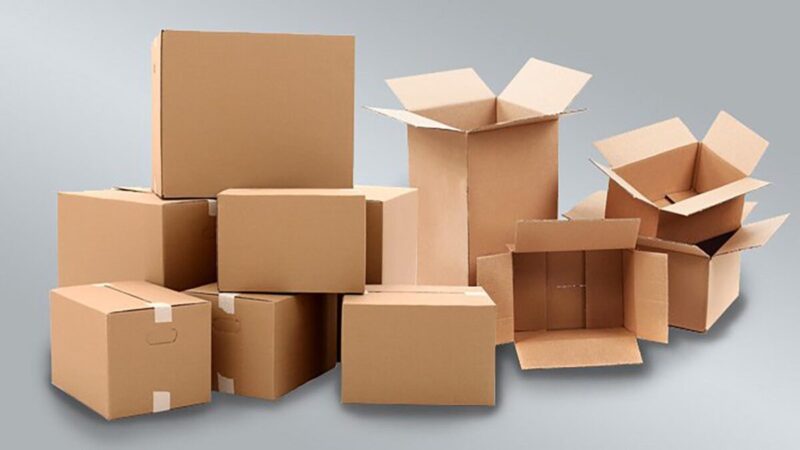
Product packaging
You need to package the product itself. This will instantly protect any product you sell. Think of the shampoo bottle, the wrapper for a candy bar, or the box of jewelry you’re selling. Product packaging also includes labels and/or hang tags (if applicable) on these products. For example, our products are made of natural crystal or jade. The body of the product is relatively fragile, so safe packaging is crucial.
Straightforward product packaging will likely take center stage, so that’s where you should start. If customers see it on the shelf, what makes them want to get it? Both functionality and aesthetics are important here. When a person is shopping, the first impression is often one of the most important factors in his final decision, followed by factors such as price, quality, and function.
Outer Product Packaging
If you ship your product to a customer, how do you package it? Envelopes, boxes or something else? Alternatively, you can hand out shelving boxes to sell these candy bars to boutiques or small local businesses; what do those boxes look like?
The outer product packaging is the box or package in which your product will be delivered, this is especially important for shipping purposes, it will ensure that your product ends up in the customer’s hands intact. They usually include branded mailboxes, envelopes and stickers. This gives you the opportunity to impress customers the moment they see the package in the mail.
Internal product packaging
If you need product packaging, you may also need product inner packaging. This includes everything inside the outer box or envelope that is not the product itself. It may include shredded paper or blister, used to hold everything in place, and to avoid or reduce collisions during transport.
The main focus here is practicality. How can you ship the lotion in that glass bottle and make sure it doesn’t break? For example, wrapping the item in a cloth bag or paper and sticking it in shredded paper can help protect it.
All of these can be branded to give your packaging a more uniform look so your brand looks mature and professional. It also gives you control over the complete customer experience when it comes to how they receive your product.
How to pack a product: 6 things you need to put on a box.
When designing product packaging, there are six things to keep in mind every time. These include:
- Product title. What is the product name? It needs to be on the packaging.
- Explain what the product is. This could be a simple tagline, or it could be a small section somewhere on the label detailing what it does.
- Instructions on how to use and care for it. For example, clothes may only be hand washable, or you may be selling camping gear that is only suitable for certain weather conditions.Details directly on the product.
- This includes the brand logo and anything your designer comes up with that is specific to the product itself.
- Required information such as safety labels, nutrition labels or barcodes. Certain industries and regions require this information, depending on the products you sell. Double check and see what you need to put on the packaging.
- Lot number and other required information. Even if the number obviously changes, you need to make sure there is room for it somewhere on the package.
How to Design Ecommerce Packaging: 6 Key Steps
The brand packaging process involves six key steps. Let’s take a look at each one.
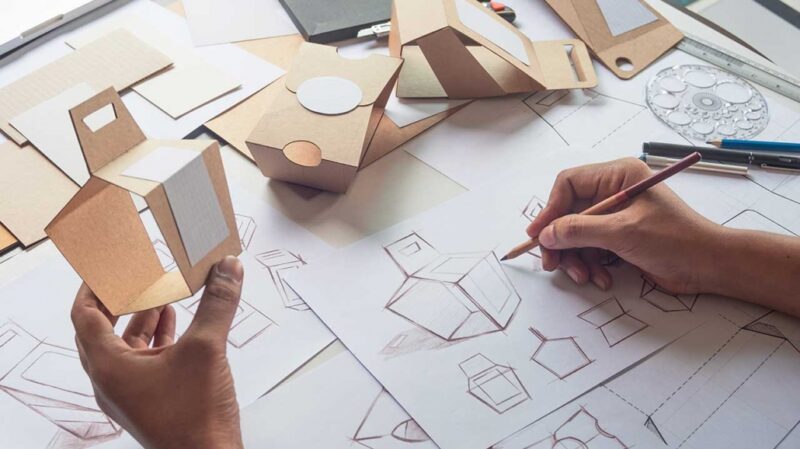
1. Do your research
Do your research in advance. We covered this in an earlier post. You need to know who your audience is, what’s going on in the market right now, and what you want your packaging to say about the product you’re selling. Competitor and market research will be important here, and also useful if you haven’t developed buyer personas for each individual product.
Branding and packaging go hand in hand. Please keep this in mind.
2. Select your product container type
It is important to decide what type of product container you may need before you make any further decisions. Different options for product packaging include:
- Box
- Canned
- Bottle
- Glass jar
- Laminated envelopes
- wrapping paper
- Carton cardboard tube
Remember to choose something that meets all of the following criteria:
- Looks good.
- If there is an industry standard, it meets user expectations.
- Its function.
- It can be shipped safely.
3. Decide what you need
Once you’ve chosen the exact type of product container you want to use, it’s time to look at everything else you might need.
Consider how your products will get from your store to your customers from a practical and aesthetic standpoint. You will need a shipping container, such as a mailing envelope or box. But what else do you need to make sure everything looks great and the product is protected so that customers have the best experience?
In addition to that brand of shipping box, you may also want to buy a brand of packing tape. Maybe you have a standard product kit that can easily benefit from a custom mailing insert, or maybe you realize you need to pack peanuts or shredded paper to ensure your products reach customers safely.
Consider all of this and list everything you need. Moving forward is important.
4. Design packaging
This may be a one-time cost and you hire someone to design the packaging you need, both outer and inner.
At this stage, clarify the color scheme, imagery, and overall aesthetic you want. It’s important to make sure you know exactly what your product is so that if someone sees it on the shelf, they don’t get confused. Remember to include everything you need on the packaging, including lot numbers and/or safety information. If you forget it the first time, you’ll have to start from scratch (and pay to redo it).
Many printing companies offer packaging design services to simplify the process for you. You just tell them what you want and they can handle the more technical logistics for you. It’s also a good idea to explore graphic design packaging services on marketplaces like Fiverr. There is no shortage of talented designers out there who can craft visually appealing packaging designs.
5. Get feedback
Once the design is complete, it will be returned to you for approval. Review carefully. Double-check all copies to make sure it’s exactly what you want it to look like (or better!) as you envision it.
Once you have the final design, get feedback. Ask peers with experience in the e-commerce or retail industries who want you to succeed, or friends you trust with design tastes. If possible, you can even ask members of your target audience whose opinions are important when it comes to actually buying the product.
This can be a big decision, so you want to be prepared before you start ordering.
6. Start the printing process
Once you’re ready to create your package, all that’s left to do is find a printer and make things happen. The following options are all good choices for packaged products:
- Sticker mules for product packaging labels can be attached to external packaging such as boxes or jars
- UPrinting and Packlane for custom designs, including product boxes, mail boxes and shipping boxes
- PrintingForLess works with everything from custom candy wrappers, gift card holders, cinch straps, hang tags, folding cartons and inserts
- Lumi is suitable for tapes, tissues, mailing bags, laminated bags, cotton bags and envelope sleeves.
Many printers allow you to make prototypes before ordering a full batch. Use this to make sure everything is perfect.
If you don’t want to deal with too many processes. Then, leave the packaging solution to your product supplier. Hand over your designs and requirements to them, and they will handle all your next steps, including sample feedback, production, printing, and shipping.
For example, our company – Deyi Gems will provide customers with one-stop packaging solutions. We will combine the products selected by customers and the requirements of customers, so as to provide customers with some reasonable packaging suggestions, including packaging materials, packaging styles, logo positions, and all details such as inner packaging and outer packaging. We are not only the source producer and supplier of jade gua sha boards, but also a one-stop solution provider.
Best Product Packaging Design Inspiration
Looking for some packaging design ideas to give you some inspiration? Check out these incredible examples of e-commerce packaging, all of which are versatile and can be easily adapted to your brand at low cost.
1. AB's Skinfood
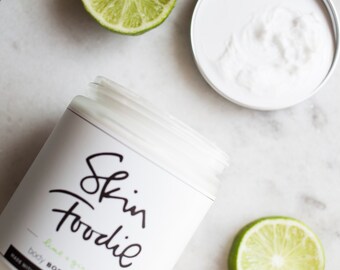
AB’s Skinfood is an Etsy store that sells organic, handcrafted natural beauty products. Their packaging layout is excellent, which in part helps them secure deals with well-known companies like Whole Foods.
This little brand has gorgeous packaging that gives the store an established feel. The clean white label is still different from the brand name and the product name below.
2. Rockin' Green
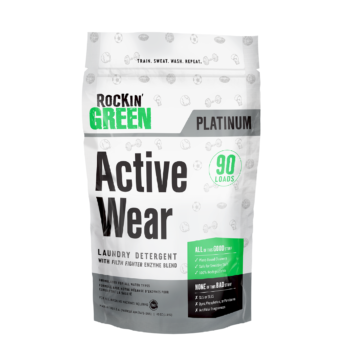
Laundry powder comes in a bottle, right? unnecessary.
Rockin’ Green’s detergents are in powder form rather than liquid form, so it makes sense that their packaging also looks different than expected. They used a plastic bag with a small spoon inside.
In addition to doing something different (which can also be neater than a messy detergent bottle), their product packaging is also clean and tells customers exactly what each item is. They list “Active Wear” in big bold letters and “90 loading” in bright green text in the upper right corner. They’re also there to explain why the product is great and how it contains “no bad stuff”. It’s a powerful retail package, whether you’re selling online or in store.
3. Sephora
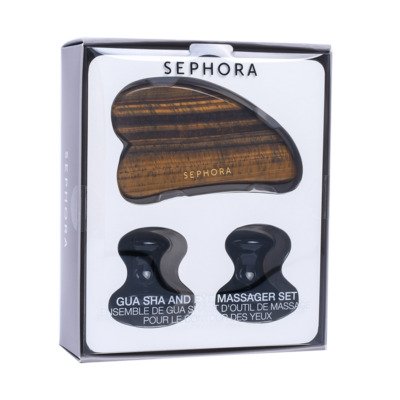
This is the packaging we make for Sephora and contains the products we make. This kind of packaging is suitable for offline supermarkets and use with display racks.
The design of the entire package is very simple, with only the brand’s logo and the name of the product on the front of the outer package. Transparent plastic packaging is used on the front to maximize the prominence of the product. The internal buckle design can also ensure the safety of the product.
The variety of products in the supermarket is very rich, so it is very important to make a deep impression on customers at the first time. If you are full of information about the quality and style of your product, you might as well display it generously.
in conclusion
The product packaging design process is obviously an involved process that cannot be taken lightly. It makes or breaks your brand, so it’s important to make decisions strategically. The best packaging will strike a balance between cost-effectiveness and visual impact, and will stay true to your brand and what your audience wants to see.
Summary: How do I design packaging for my product?
- Do your research
- Choose a product container
- Get other necessities (brand packing tape, shredded paper, etc.)
- Design packaging
- Get feedback
- Start the printing process
- Too troublesome? Leave it to your product supplier all the way!

